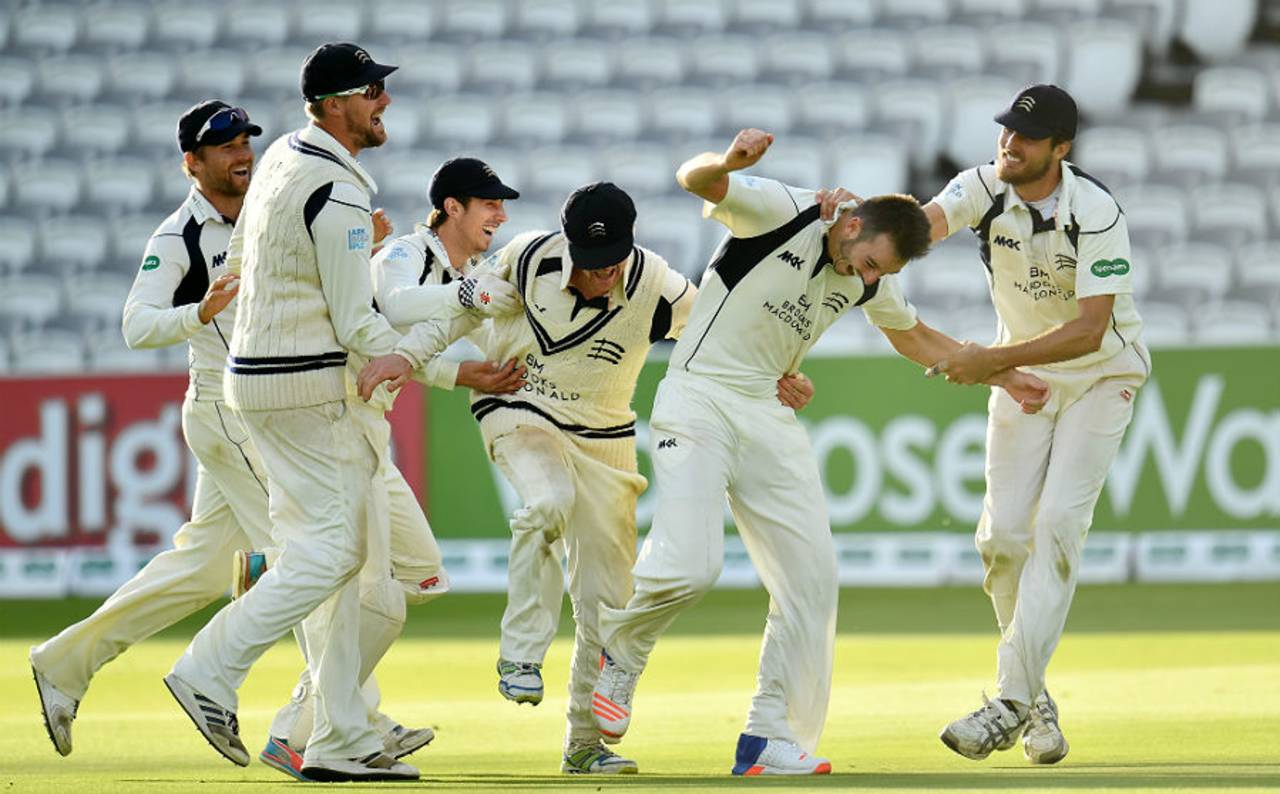The discreet charm of the County Championship
The competition retains a certain purity precisely because it is unfashionable and anachronistic, and is not loaded down by the requirements of television and sponsors
Jon Hotten
26-Sep-2016

Plenty came to Lord's to watch the title match of this year's County Championship (though you couldn't tell from this picture) and hundreds of thousands more were there in spirit • Getty Images
Increasingly, cricket seems to have just one subject, the subject of time. Cricket fights time, struggles with its changes, but in other ways embraces time, puts time at the heart of its drama. As the autumnal sun, soft and fragile, fell down on Lord's at the end of this year's County Championship, time in all of these aspects was refracted.
The match had finished in the way it might in a kid's back-garden imagination: three teams in the fight, two engaged in the battle at cricket's HQ, the other watching anxiously on television 170 miles away (and lucky that Sky decided at the last minute to show the game, otherwise they'd have been clustered around a radio…). Within two hours the game moved from the farce of lob-up bowling to a desperate race against the clock and the light, settled at the death by a nerve-rattling hat-trick from an unsung hero. It was particularly, peculiarly English: nostalgic, anachronistic, dreamy, and almost impossible to explain properly to outsiders.
The drama had built not just on the last afternoon or during the final round of matches, but across a season that began under iron skies on April 10. Behind that lay history, of Yorkshire, the defending champions; of Middlesex, who had not won the title since 1993, when their current director of cricket was still chuntering in, through wind and rain, from the Nursery End; and of Somerset, who have not held the gold trophy at all since the County Championship was constituted at Lord's on December 10, 1889, when the Marquis of Salisbury was prime minister and the Wisden Almanack named six bowlers as its first Cricketers of the Year, among them George Lohmann and Bobby Peel.
To compete in the County Championship is to join this great history, this vast story, to feel the weight of Yorkshire's 32 titles, Phil Mead's 46,268 runs, Tich Freeman's 3151 wickets, to stand alongside the deeds of Grace and Hutton and Ramprakash, of King Viv and Big Bird and Dasher Denning, of Clive Radley, Mike Gatting, Vince Van der Bijl; of Imran and Sarfraz and Malcolm Marshall and the thousands of other cricketers who have played across the summers. It's a rich and rare place, and it's not too fanciful to suggest that all of those summers played into this one, and offered it meaning and power.
Time is sometimes an enemy. The Championship does not fit with modern life. If cricket were being conceived now, it would be in its three-hour form of boozy Friday night crowds and heightened, manic action. The Championship began in the era of steam and has survived until steam punk. It has endured through global schisms and wars from which its players did not return. It is cast as cricket's crazy old uncle who insists on turning up at the party each year, even though accommodating him and his 18 mates is becoming increasingly inconvenient.
The Championship began in the era of steam and has survived until steam punk. It has endured through global schisms and wars from which its players did not return
This is the story anyway, the one we all know, about county cricket's great irrelevance. But as time accelerates and attention spans shorten to mouse-clicks, the internet age has offered something strange and new. A visit to the Championship may be impossible physically, but it is now happening virtually, and it is happening a lot. On digital radio, the BBC broadcast 3889 hours of coverage. Live blogs, including the popular one right here on this site, were read frantically in workplaces and on mobiles. Twitter offers a constant presence. And Lord's announced on Sunday that 21,595 people managed to escape their lives and watch the four days of Middlesex versus Yorkshire, making it the biggest crowd for a single Championship game there since May 1966, a time before England won the football World Cup.
It is a modern riddle, a metaphor for where we're going: the Championship now exists for those who can't watch it but would like to. It retains a purity of competition precisely because it is unfashionable, takes its own sweet time and is not loaded down by the requirements of television and sponsors. Most of its players labour knowing that they have reached the heights that they are going to reach, and that one day they will have to rejoin the real world, for which their current lives cannot prepare them. It's real and human and touching, a quotidian kind of sporting heroism.
As each season folds into autumn, some of them ride into the sunset, and they only need look at Twitter or the live blogs to see what they have meant and what they leave behind. Each goes out with a story, be they beloved old warhorses like David Masters and Graham Napier at Essex, or young men who have been granted fleeting careers, like Sussex's remarkable Lewis Hatchett. Others sweat on contract renewals and hunt for gigs in club cricket somewhere in the southern-hemisphere sun to kill another winter.
This bittersweetness underpins cricket in England. The County Championship understands time and its challenges, and it has weathered them all. Once you've seen enough summers pass, you come to realise how transient they are and how quickly they come and go. What once seemed endless is over too soon.
Jon Hotten blogs here. @theoldbatsman